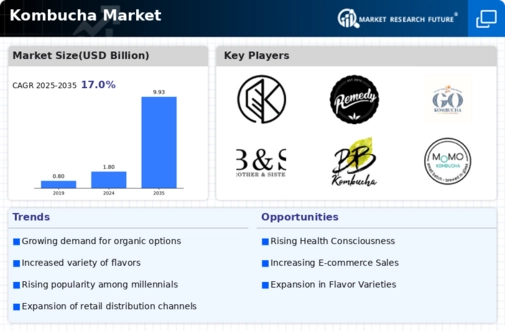Market Share
US Kombucha Market Share Analysis
In the bustling landscape of the US Kombucha market, businesses deploy various strategies to carve out their slice of the market share pie. One prevalent approach is differentiation, where companies emphasize unique features or qualities to stand out amidst competition. This could entail offering a diverse range of flavors, incorporating exotic ingredients, or focusing on organic and locally-sourced ingredients to appeal to health-conscious consumers. By positioning themselves as distinct from other brands, companies seek to attract niche segments of the market and cultivate brand loyalty.
Another key strategy is pricing, which plays a pivotal role in market share positioning. Some brands opt for premium pricing, positioning themselves as high-end products targeting affluent consumers willing to pay a premium for quality and exclusivity. On the other hand, there are brands that adopt a more affordable pricing strategy, aiming to capture a larger market share by appealing to budget-conscious consumers. Price promotions, discounts, and bundle deals are common tactics employed to sway consumers' purchasing decisions and gain a competitive edge.
Furthermore, distribution channels play a crucial role in market share positioning within the US Kombucha market. Companies strategically leverage various distribution channels such as supermarkets, health food stores, convenience stores, and online platforms to reach their target audience. By ensuring widespread availability and accessibility of their products, brands can effectively penetrate different market segments and increase their market share. Additionally, partnerships with distributors and retailers can help brands secure prominent shelf space and visibility, further enhancing their competitive position in the market.
Brand image and marketing efforts also influence market share positioning in the US Kombucha market. Building a strong brand identity centered around values such as sustainability, authenticity, and transparency can resonate with consumers and differentiate a brand from its competitors. Effective marketing strategies, including social media campaigns, influencer partnerships, and experiential marketing events, can help raise brand awareness and foster consumer engagement. By consistently reinforcing a positive brand image, companies can strengthen their position in the market and attract a loyal customer base.
Moreover, innovation plays a vital role in maintaining a competitive edge and capturing market share in the US Kombucha market. Companies invest in research and development to introduce new flavors, formulations, and packaging innovations that cater to evolving consumer preferences and trends. Whether it's experimenting with unique ingredients, introducing functional benefits, or exploring sustainable packaging solutions, innovation allows brands to stay relevant and capture the attention of consumers in a crowded market landscape.
Lastly, strategic partnerships and collaborations can provide brands with opportunities to expand their market share and reach new audiences. Teaming up with complementary brands or participating in co-marketing initiatives can amplify brand exposure and drive sales. Collaborations with wellness influencers, fitness studios, or food festivals can help brands tap into niche communities and cultivate brand advocacy among passionate consumers. By leveraging the strengths and resources of strategic partners, brands can enhance their market position and seize growth opportunities in the competitive US Kombucha market.










Leave a Comment